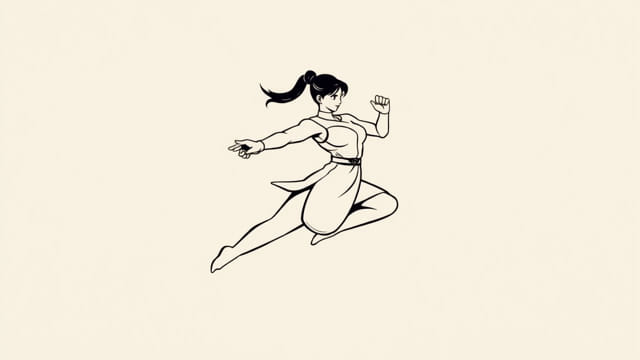Chun-Li, the iconic martial artist from the legendary Street Fighter series, is instantly recognizable by her signature rapid-fire kicks. Among these, her ‘Lightning Legs’ move known for its flurry of fast, repeated kicks has become one of the most memorable and debated special attacks in fighting game history. The phrase ‘countless kicks’ doesn’t just refer to the speed and volume of the move, but also to the influence this technique has had on gameplay, balance discussions, and the overall representation of female characters in gaming. One topic that often surfaces is the ruling or balance around Chun-Li’s countless kicks in competitive play. How are they viewed? Are they overpowered, fair, or just iconic? Let’s explore the history, mechanics, rulings, and impact of Chun-Li’s legendary leg-based offense.
Origins of Chun-Li’s Countless Kicks
Chun-Li made her debut inStreet Fighter IIin 1991 as the first female character in a mainstream fighting game. Her fighting style, based on Chinese martial arts, was defined by agility, speed, and finesse. Among her primary tools was a move where she flutters her legs in place to deliver a barrage of high-speed kicks. Officially known as the ‘Hyakuretsukyaku,’ or ‘Hundred Rending Legs,’ this attack has become a symbol of Chun-Li’s offensive pressure and is often referred to by fans as the Lightning Legs.
Key Mechanics of the Move
- Input Method: Traditionally executed by rapidly pressing a kick button.
- Attack Speed: The kicks come out in a flurry, making it hard for opponents to counter.
- Combo Utility: Can be linked into combos for additional damage and pressure.
- Zoning Tool: Useful for keeping opponents at bay and punishing close-range attempts.
The countless kicks are not just for show; they are a practical and reliable part of Chun-Li’s toolkit that can swing matches in her favor when used strategically.
Rulings in Competitive Play
Across multiple Street Fighter titles, Chun-Li’s Lightning Legs have occasionally been the subject of competitive scrutiny. Tournament organizers and balance patch developers have analyzed the move’s effectiveness to ensure it fits within fair gameplay dynamics.
Balance Considerations
- Damage Scaling: In some versions of the game, the kicks have been toned down to avoid overly punishing opponents.
- Startup Frames: Adjustments have been made to the move’s initiation time to ensure it’s not abusable.
- Combo Restrictions: Newer Street Fighter entries have placed limits on how the kicks can be comboed from other moves.
Despite these tweaks, the move remains legal and widely used in competitive scenes. It is not considered broken or banned but does require skill to execute properly, especially under tournament pressure.
Meta Impact in Various Titles
Chun-Li’s effectiveness has varied across different versions of Street Fighter. Her countless kicks have been both a blessing and a burden, depending on how they were balanced in each game.
Street Fighter II
In the original game, Chun-Li’s kicks were an early standout move, allowing new players to spam an effective attack and veteran players to use it tactically. It was simple to activate and could dominate inexperienced opponents.
Street Fighter Alpha Series
Her kicks were refined to be more technical, requiring better timing and combo understanding. This made the move less spammy but more rewarding for skilled players.
Street Fighter IV and V
Later entries gave Chun-Li more complex cancel options and air versions of her kicks. Her countless kicks became integrated into high-level strategies, especially in corner pressure and combo chains.
Street Fighter VI
In the most recent version, the Lightning Legs remain a core part of her strategy. Developers have struck a better balance between visual flair and competitive fairness. The move fits naturally into her rhythm, offering combo extensions without being oppressive.
Competitive Usage and Strategy
Top-tier players often utilize Chun-Li’s countless kicks for offensive pressure. The key lies in how and when the move is executed random usage can be punished, while calculated inputs can overwhelm opponents.
Strategic Applications
- Corner Pressure: Pinning opponents with repeated kicks to reduce their escape options.
- Combo Finishers: Using the kicks to extend or end combos for optimized damage.
- Chip Damage: Forcing opponents to block the kicks repeatedly can lead to chip-out KOs.
- Whiff Punishing: Catching opponents’ missed attacks with a fast Lightning Legs punish.
In hands of expert players, Chun-Li’s countless kicks are not just button mashing they are a carefully planned execution of timing, rhythm, and awareness.
Visual and Cultural Icon
Beyond gameplay, Chun-Li’s countless kicks have become a defining trait of her character in popular culture. Her flurry of strikes is instantly recognizable and often mimicked in fan art, cosplay, and animations.
Pop Culture References
- Frequently featured in arcade advertisements and game trailers.
- Used in parody and homage scenes in TV shows and movies.
- Merchandise, including action figures, often emphasizes her Lightning Legs pose.
Her kicking style has helped solidify Chun-Li not only as a strong fighter in the game but also as a symbol of powerful female representation in gaming history.
Chun-Li’s countless kicks have been a cornerstone of her fighting identity since her inception. While the move has undergone numerous changes across different games, its spirit remains intact a lightning-fast barrage that demands respect from opponents. Far from being a cheap tactic, the Lightning Legs now reflect the balance of execution and strategy required in high-level play. Whether you’re a new fan of Street Fighter or a veteran competitor, understanding the ruling and application of Chun-Li’s countless kicks is essential to appreciating her role in the game’s competitive meta and her enduring legacy in video game culture.
